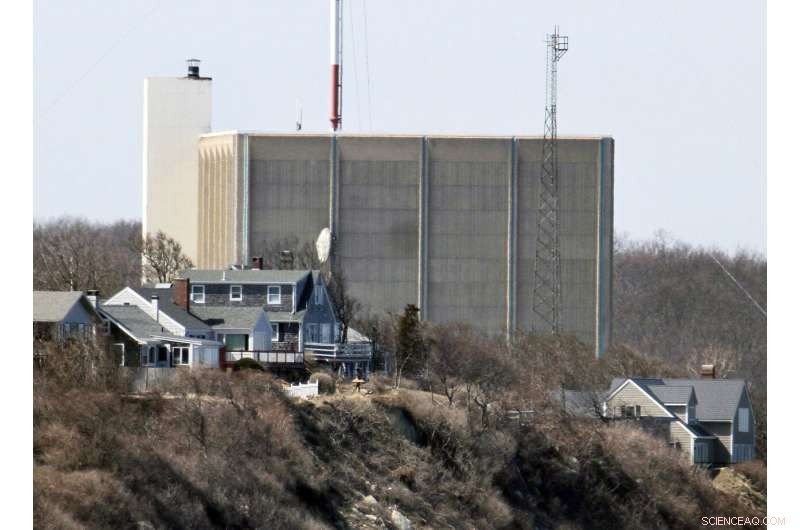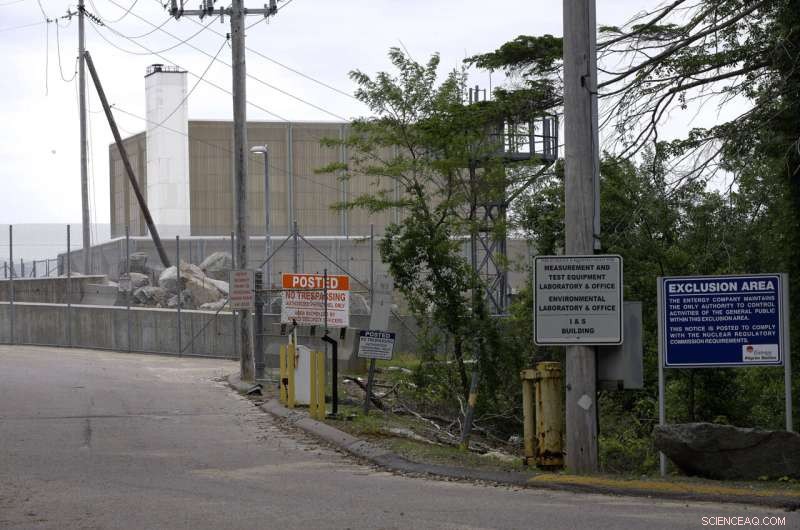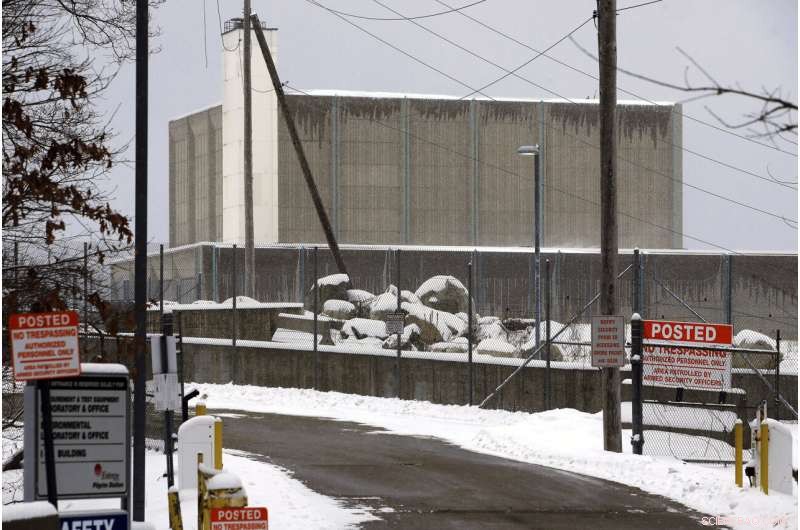
Una parte della centrale nucleare di Pilgrim è visibile oltre le case lungo la costa della baia di Cape Cod, a Plymouth, Massachusetts, il 30 marzo 2011. Pilgrim, chiuso nel 2019, era un reattore ad acqua bollente. L'acqua circolava costantemente attraverso il reattore e il combustibile nucleare, convertendolo in vapore per far girare la turbina. L'acqua è stata raffreddata e fatta ricircolare, raccogliendo la contaminazione radioattiva. Credito:AP Photo/Steven Senne, File
Un milione di galloni di acqua radioattiva si trova all'interno di un'ex centrale nucleare lungo la baia di Cape Cod e deve sparire.
Ma dov'è, la domanda irritante, e lo stato interverrà quando deciderà la società che smantella l'impianto?
Holtec International sta valutando la possibilità di trattare l'acqua e scaricarla nella baia, attirando una feroce resistenza da parte di residenti locali, pescatori di conchiglie e politici. Holtec sta anche valutando la possibilità di far evaporare l'acqua contaminata o di trasportarla su camion in una struttura in un altro stato.
La lotta in Massachusetts rispecchia l'acceso dibattito in corso in Giappone su un piano per rilasciare nell'oceano oltre 1 milione di tonnellate di acque reflue radioattive trattate dalla centrale nucleare distrutta di Fukushima nella primavera del 2023. Un enorme tsunami nel 2011 si è schiantato contro l'impianto. Tre reattori si sono fusi.
La centrale nucleare del pellegrino a Plymouth, nel Massachusetts, è stata chiusa nel 2019 dopo quasi mezzo secolo di fornitura di elettricità alla regione. Il rappresentante degli Stati Uniti William Keating, un democratico il cui distretto comprende il Capo, ha scritto a Holtec con altri importanti legislatori del Massachusetts a gennaio per opporsi al rilascio di acqua nella baia di Cape Cod. Ha chiesto alla Commissione di regolamentazione nucleare degli Stati Uniti di esaminare i suoi regolamenti.
Keating ha affermato a fine marzo che la gestione dell'acqua radioattiva da parte di Holtec potrebbe creare un precedente perché l'industria statunitense della disattivazione è agli inizi. La maggior parte delle centrali nucleari statunitensi sono state costruite tra il 1970 e il 1990.
"Se ascoltano, sono sensibili e lavorano con queste comunità, è importante", ha detto. "Questo è il messaggio per i futuri siti di disattivazione."
Holtec ha acquisito centrali nucleari chiuse in tutto il paese nell'ambito della sua attività di smantellamento, tra cui l'ex Oyster Creek Generating Station nel New Jersey e l'Indian Point Energy Center a New York. Sta prendendo la proprietà della centrale nucleare di Palisades sul lago Michigan, che chiuderà quest'anno.
Pellegrino era un reattore ad acqua bollente. L'acqua circolava costantemente attraverso il reattore e il combustibile nucleare, convertendolo in vapore per far girare la turbina. L'acqua è stata raffreddata e fatta ricircolare, raccogliendo la contaminazione radioattiva.
Cape Cod è una meta turistica. Avere acqua radioattiva nella baia, anche a bassi livelli, non è eccezionale per il marketing, ha affermato il rappresentante dello stato democratico Josh Cutler, che rappresenta un distretto lì. Cutler sta lavorando per approvare una legislazione che vieti lo scarico di materiale radioattivo nelle acque costiere o interne.
Holtec ha affermato che Pilgrim scaricava acqua nella baia già da 50 anni mentre l'impianto era in funzione e gli studi ambientali, condotti dagli operatori dell'impianto e ora da Holtec, hanno mostrato un impatto ambientale minimo o nullo. I rapporti ambientali radiologici sono condivisi annualmente con l'NRC.
"Stiamo lavorando per fornire dati scientifici, educare il pubblico sulla realtà delle radiazioni nella vita di tutti i giorni e fare in modo che gli esperti spieghino la vera scienza contro la paura emotiva dell'ignoto", ha scritto il portavoce Patrick O'Brien in un'e-mail a marzo .

Warning signs are posted near a gate to the Pilgrim Nuclear Power Station, in Plymouth, Mass., Tuesday, May 28, 2019. Pilgrim, which closed in 2019, was a boiling water reactor. Water constantly circulated through the reactor vessel and nuclear fuel, converting it to steam to spin the turbine. The water was cooled and recirculated, picking up radioactive contamination. Credito:AP Photo/Steven Senne, File
WHAT ARE HOLTEC'S OPTIONS?
Holtec could treat the water and discharge it in batches over multiple years, likely the least expensive option. Or, it could evaporate the water on site, as it says it has done with about 680,000 gallons (2,600 kiloliters) over the past two years.
Evaporating the water would be more challenging to do now because the spent nuclear fuel is in storage, and couldn't be used as a heat source. Holtec would have to use a different—likely more expensive—method that would release gas.
Or, Holtec could truck the water to an out-of-state facility, where it could be mixed with clay and buried or placed in an evaporation pond, or released into local waterways. That's what Keating wants.
Vermont Yankee Nuclear Power Station, another boiling water reactor, was shut down in Vernon, Vermont, in 2014. It's sending wastewater to disposal specialists in Texas and other states. Entergy operated and sold both Vermont Yankee and Pilgrim. NorthStar, a separate and competing corporation in the decommissioning business, is dismantling Vermont Yankee.
Nuclear plants occasionally need to dispose of water with low levels of radioactivity when they're operating, so a process to release it in batches into local waterways was developed early in the nuclear industry.
In recent years at Pilgrim, the two largest releases were in 2011, with 29 releases totaling about 325,000 gallons (1,500 kiloliters), and 2013, with 21 releases totaling about 310,000 gallons.
The water from those releases was well below the federal limits for the amount of radionuclides in millirems a person would be exposed to in a year if they ate local seafood or swam in nearby waters, according to the NRC.
NRC spokesperson for the Northeast Neil Sheehan said the limits are set very conservatively and are believed to be protective of the public and environment. He said it's important to consider the role of dilution—once the discharges mix with vast quantities of water any radioactivity is typically not detectable.
WHY ARE PEOPLE WORRIED?
In Duxbury, Kingston and Plymouth Bays, there are 50 oyster farms—the largest concentration in the state, worth $5.1 million last year, according to the Massachusetts Seafood Collaborative. The collaborative said dumping the water would devastate the industry, and the local economy along with it.
Diane Turco, a Harwich resident and longtime Pilgrim watchdog, questions if the water is heavily contaminated, especially from the pool that covered the stored, spent fuel for cooling and shielded workers from radiation.

A no trespassing sign is posted near the entrance to the Pilgrim Nuclear Power Station, at rear, Thursday, Feb. 28, 2019, in Plymouth, Mass. One million gallons of radioactive water is contained inside the former nuclear power plant along Cape Cod Bay. The plant's owner, Holtec International, is considering treating the water and discharging it into the bay. Local residents, shell fishermen and politicians disapprove of the plan. Credito:AP Photo/Steven Senne, File
"Isn't this a crazy idea for Holtec to use our bay as their dump? No way," she said.
Others didn't know Pilgrim's water went into the bay in previous years and they don't want it to happen again.
"We can't change that, but we can change what's happening in the future," said Cutler, the state lawmaker. "It's the first time it has ever been decommissioned, so to compare this to the past is a convenient excuse. 'Well, we did it in the past,' that sounds like my kid."
Towns on the Cape are trying to prohibit the dispersal of radioactive materials in their waters. Tribal leaders, fishermen, lobstermen and real estate agents have publicly stated their opposition as well.
Sheehan, the NRC spokesperson, said the water is not different or distinct, compared to water released during the plant's operations. Holtec would have to handle it the same way, by filtering it, putting it into a tank, analyzing the radio isotopes and calculating the environmental impacts if it was released in batches, he added.
WHO GETS THE FINAL SAY?
Holtec wouldn't need a separate approval from the NRC to discharge the water into the bay. However, Holtec would need permission from the U.S. Environmental Protection Agency if the water contained pollutants regulated by the Clean Water Act, such as dissolved metals.
If the water contained only radioactive materials regulated by the NRC, Holtec wouldn't need to ask the EPA for a permit modification, according to the EPA's water division for New England. Holtec has never given the EPA a pollutant characterization of the water associated with decommissioning, the division's director said.
Mary Lampert, of Duxbury, is on a panel created by the state to look at issues related to the Pilgrim's decommissioning. She believes the state could use its existing laws and regulations to stop the dumping and plans to press the Massachusetts attorney general to file a preliminary injunction to do so.
The attorney general's office said it's monitoring the issue and would take any Clean Water Act violations seriously.
Holtec said this week it's examining the water for possible pollutants but the lab results won't be available for awhile.
The company expects to decide what to do with the water later this year. Discharge, evaporation and some limited transportation will likely all be part of the solution, Holtec added.